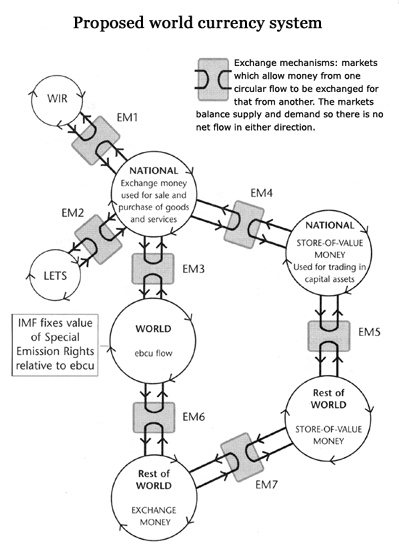Appendices
Appendix 1: How the exchange mechanisms operate
Appendix 2: References
Appendix 3: Resource Guide
 PDF version
PDF version
Appendix 1: How the Exchange Mechanisms Operate
 All seven exchange mechanisms balance supply and demand by altering the relative price of the pair of currencies being exchanged between them. There is therefore no net movement of currency from one circular flow to another.
All seven exchange mechanisms balance supply and demand by altering the relative price of the pair of currencies being exchanged between them. There is therefore no net movement of currency from one circular flow to another.
EM1 Allows people with earnings in a Wirtschaftsring-type system to exchange them for the national exchange currency, and vice versa.
EM2 Allows members of a LETS to exchange their units for the national exchange currency, and vice versa.
EM3 Ensures that flows of money from imports and exports balance each other. Ebcus from exports and the sale of SERs are exchanged for units of the national exchange currency which people provide in payment for imports and the purchase of SERs.
EM4 Allows people with exchange money they wish to save to swap it for store-of-value money provided by people who need to spend their savings or who have taken out a loan repayable in over twelve months.
EM5 Balances capital flows (which are in the store-of-value currency) into and out of the country.
EM6 Is a composite of all the EM3-type exchanges operated by the rest of the world.
EM7 Balances the flow of money into savings with the flow of money out of savings for the rest of the world.
IMF This is the only fixed point in the systems. If ever the price of an SER in terms of ebcu rises beyond a certain point as a result of exchanges between countries, the IMF will supply SERs and reduce the world's ebcu stock.
Continue to Appendix 2: References
Go to Feasta website



